Unleashing Artistic Potential in Hong Kong
An Interview with Scarlette Cheng
BY EMMALY WIEDERHOLT
Scarlette Cheng is a dance facilitator and administrator in Hong Kong. She is a DanceAbility instructor and runs the social enterprise Theatre in the Dark and the NGO Artscompana with her husband, a blind theater educator. Here, she discusses how she became passionate about creating dance and theater opportunities for people with disabilities, what accessibility is like in Hong Kong, and how she hopes to create more platforms for people with disabilities to flourish in the arts.
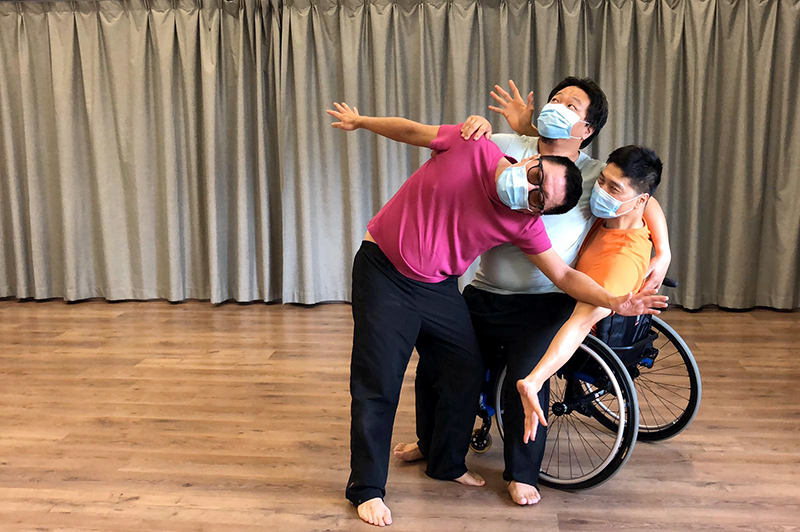
Footage for World Dance Day 2020 in Hong Kong
Image description: Three dancers are in a tight clump, all reaching their arms in different directions. One is in a wheelchair, and the other two are gently leaning into him.
~~
Can you tell me a little about your dance history – what shaped who you are today?
I started my first dance class when I was 25 years old, which was 20 years ago. At that time, I was working for an international NGO, and I joined my colleagues for a jazz dance class after work. It was once a week, and I continued for many years. I liked it and sometimes I joined the classes of other dance forms like flamenco, tap, and modern dance.
In 2009, I got an injury. I had pelvic displacement and I also hurt my knees. I stopped danced for about nine months, and in that period, I needed a walking aid. I started to wonder how people with body limitations could enjoy dancing. I worried that I could never dance again. I prayed that I would dance again and hoped to serve society through dance.
In 2012, I read an article by a Hong Kong dancer, Maru Yuen Kin-leung, who is the first person from Hong Kong to receive the DanceAbility teacher certification. I went on Facebook and found him. I told him I was interested in his experience and asked if there would be any opportunity to learn more. He introduced me to a dance group in Hong Kong called Symbiotic Dance Troupe.
I joined it with my friend who is now my husband. He’s a blind person. The first time we went to check out the dance troupe, there were participants in wheelchairs, people with visual impairment, the Deaf, people with developmental difficulties, the elderly, and children. I said, “Wow!” I thought it was so amazing. I joined that dance troupe for their monthly meetings.
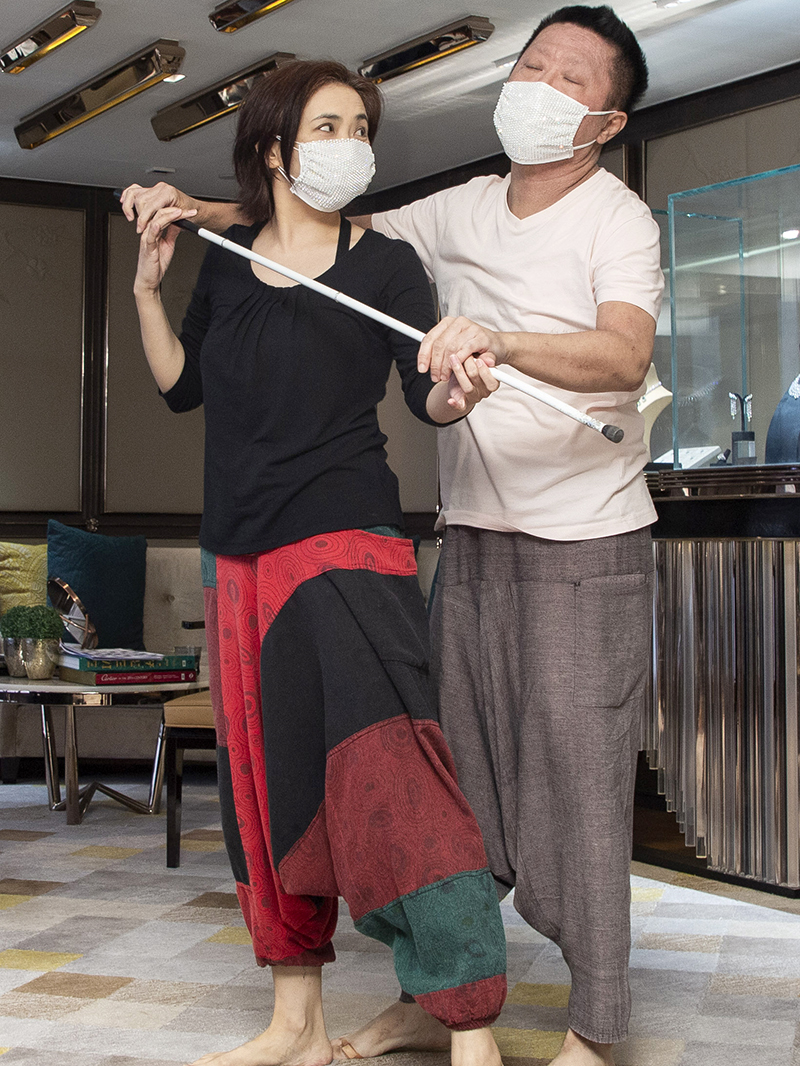
Scarlette dancing with her husband Comma at a charity collabration by Vivaz Fine Jewelry & Carers Hong Kong, Photo by Frank Freeman
Image description: Scarlette stands to the front and side of Comma, his arms reach around her, and they are both holding a white cane in front of them.
The dance troupe was under an NGO. In 2015, I was looking for a job, and the chief executive of the NGO asked me to take on the role of coordinator for the dance troupe. The organization offered to pay for me to study the DanceAbility teacher certification no matter where it happened. I became the coordinator and joined the DanceAbility teacher training in Vienna in 2016. I started to have more exposure and experience in facilitation.
I started to teach DanceAbility in special schools. I also did staff training in Taiwan and performances in Nepal, thanks to the international network of the NGO. I even got the chance to present at an international social work conference on building social inclusion with dance. I had been a social worker but did not have such exposure in the field before.
By 2019, my husband and I and one of our friends got the successful application to open a studio under First Performing Art Village, managed by the government. I decided to try and be a freelancer. I’m thankful I got some regular teaching work once a week in the special schools.
In 2013, my husband and I established a social enterprise called Theatre in the Dark where we do performances in complete darkness. The audience must experience it with their other senses. Our actors not only have visual impairments, but also some have social phobias or other disabilities, as well as ordinary actors. Sight people like me have to learn how to act in complete darkness. When the audience comes to our show, they don’t know the composition of the performers; they only know that some have disabilities. After every show, we have a meet-the-artist session. The audience is surprised to learn the princess uses a walking aid or the king is totally blind. We hope they appreciate the art in itself instead of pitying the person with the disability.
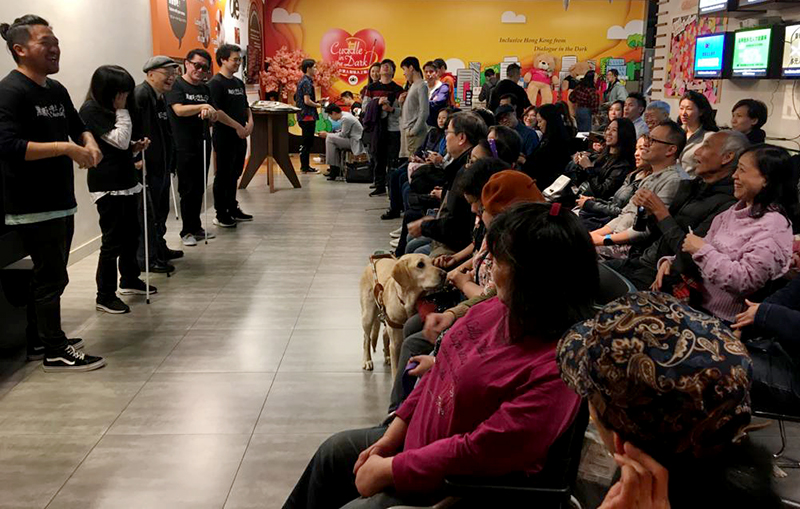
Theatre in the Dark meet-the-artists session
Image description: Five artists, two with white canes, stand before a smiling seated audience.
We also started an NGO called Artscompana Limited where we involve various art forms for people with or without disabilities. For dance, we mainly use the DanceAbility method as well as other inclusive dance elements. I’ve been inviting other people with different abilities to join my team as teaching assistants. In Chinese, “Artscompana” means arts enable someone to unleash their talents.
What are you currently working on or involved with?
I’m a member of DanceAbility Hong Kong as a certified teacher. My husband and I also run Theatre in the Dark where I’m the executive director, so most of my involvement is in administrative support and coordination. At Artscompana, I also do coordination and administration plus the dance facilitation. My husband works in theater education, and of course I do dance, so our current focus is on performing art, especially dance and theater, though we’d like to explore other opportunities with visual artists.
What kinds of populations do you usually work with?
I teach mixed abilities. I have a regular monthly dance workshop in our studio where I welcome people with different abilities to come. In the special schools, I now work with students who mainly have physical disabilities, though they may mix students with other disabilities, like students with developmental difficulties. I also have experience teaching in special schools with students who have severe mental disabilities. Because my husband is a blind person, we often work with people who have blindness. Sometimes organizations may invite me for workshops with various populations. For example, I recently taught a workshop at an organization for mental health.
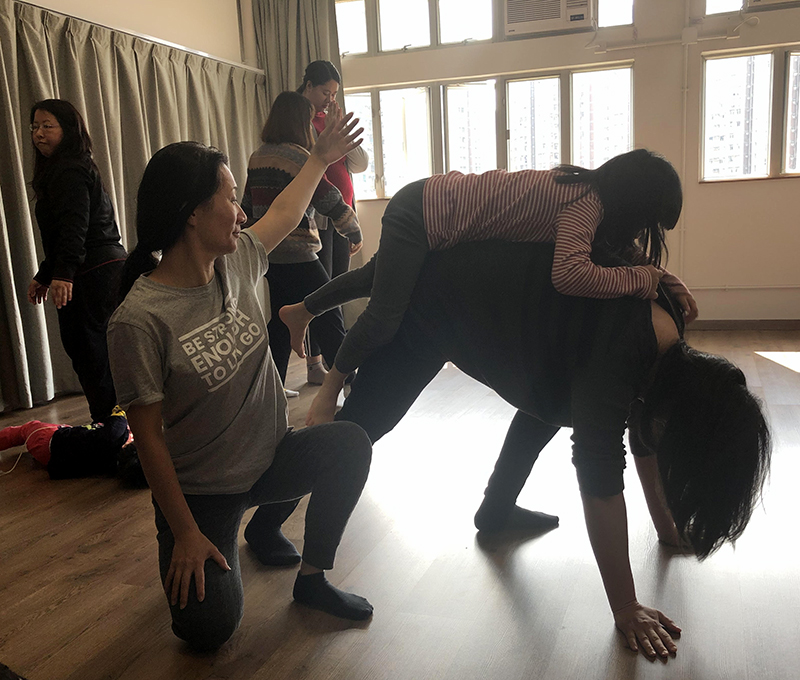
Let’s Dance – A monthly dance gathering
Image description: A dancer is on their hands and feet with a child on their back, another dancer to the side on her knee reaches over them.
In general, what kinds of opportunities are there for people with disabilities to dance in Hong Kong?
For people in Hong Kong with disabilities, they have the chance to participate in the arts, but at different levels. The first level is people with the same disability who are joined together for a class. Those classes are mostly organized by the NGOs. An instructor will come teach a class to a whole group with the same disability, like visual impairment or mental disability. This is the most common level I see in Hong Kong.
The second level is some people with a specific disability dancing with people in the community without that disability. For example, a Deaf person will dance with those who can hear, or a visually impaired person will dance with those who can see. This level is also common in Hong Kong but not as common as the first level.
The third level is mixed abilities. Most of the mixed abilities programs use DanceAbility, though some use other methods. This level isn’t as common in Hong Kong. Most of the mixed ability classes are run by certified DanceAbility teachers.
The fourth level is to have the facilitators be people with disabilities. I am hoping this will become more common. For example, one of my teaching assistants is a wheelchair user. In Hong Kong, there are few dance teachers with disabilities. People with disabilities take dance as leisure but seldom consider it as a career. My husband and I formed the NGO Artscompana because we have a mission to provide a platform for people with different abilities to participate in art, to unleash their potential, and to contribute to society through empowerment and inclusion.
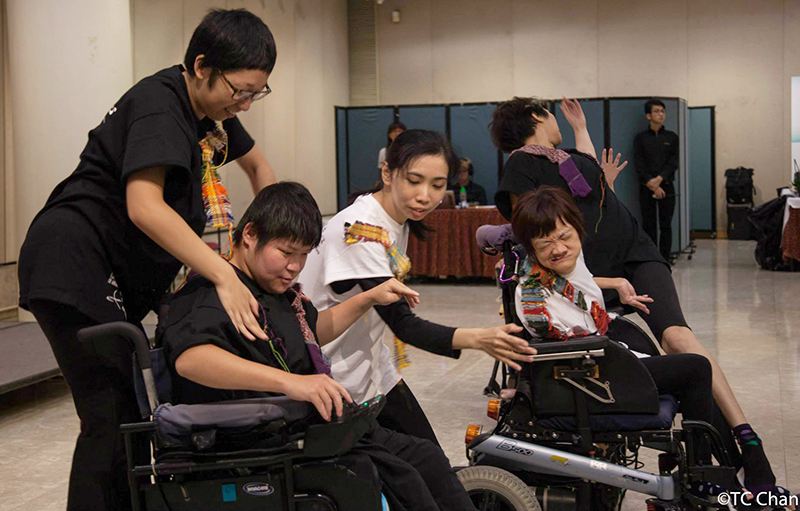
Inclusive dance performance, Photo by TC Chan
Image description: Two dancers in wheelchairs and three standing dancers pose together in a clump, all reaching their arms in different directions.
How accessible are institutions in Hong Kong?
For those with wheelchairs or walking difficulties, ramps are well established because nearly 20 years ago, a design manual for barrier free access issued by the Hong Kong Buildings Department asked new buildings to follow the guidelines. That’s why newer buildings have ramps to entrances. For other accessibility like sign language, when they broadcast the meeting of the legislative council, they have sign language interpretation and release a video afterward with subtitles.
Luckily, there are a couple of organizations in Hong Kong working on arts accessibility by doing sign language interpretation/ theatrical interpretation and audio description for arts programming. But it’s not yet popular because of resources and because the audience population with disabilities is relatively small so arts companies don’t have much awareness to spend their resources on accessibility. In Hong Kong nowadays, except with funding support, if theater or dance companies want to provide accessibility, they need to use their own resources. I once got government funding specifically for accessibility in a dance program. In the budget, I included arts accessibility and it was approved.
How has the pandemic impacted your work?
The pandemic started in Hong Kong in February. All my classes stopped, and for all of February I just delivered my classes on video. I gave a lecture to university students online and it was my first time editing a video. I stopped over 95 percent of my work for the first half of the year. Later, I started to have some Zoom workshops and some schools suggested I produce a YouTube video for the students. Currently, I’m doing YouTube videos and a little bit of Zoom. I started teaching some classes in the schools when the academic year began in September. Right now, half the time we go to the school and the other half is over Zoom. But there are no performances. Originally, we had a performance planned in October, but it’s been cut. The policy keeps changing.
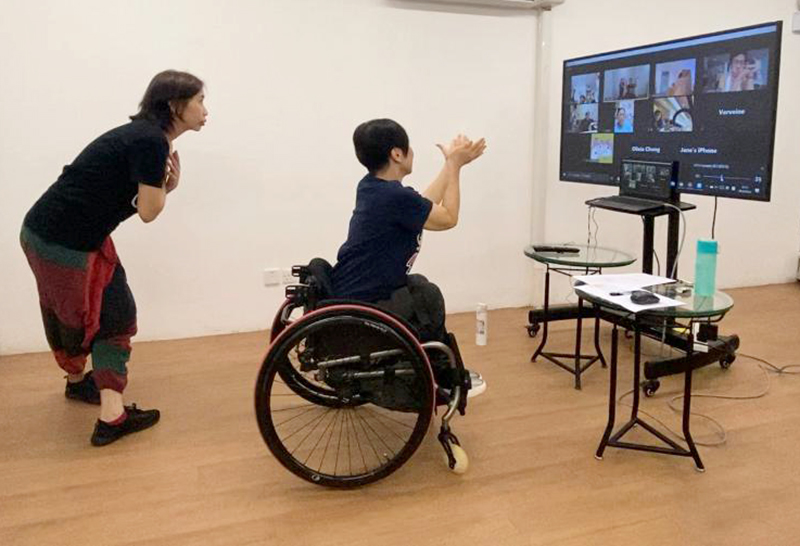
Teaching DanceAbility on Zoom, Photo by Eddie Lin
Image description: A dancer in a wheelchair and a standing dancer facilitate a dance class in front of a computer screen.
What’s next? How would you like to expand or grow your work in the future?
We have some small-scale projects. For example, I was the coordinator in Hong Kong for ON DISPLAY GLOBAL with Heidi Latsky Dance in December. 2019 was my first time joining it. This past year was virtual. We have a new project supported by Hong Kong Art Development Council which is about the dance life of artists with different backgrounds and abilities. The final output will be a video release on World Dance Day 2021.
One of our dreams is to have people with disabilities be not only participants but also facilitators. When there are classes for people with disabilities, it’s a way for them to spend their time and improve their social lives. But we think programs can go further. We want to equip people with different abilities not only by teaching them how to dance, but also by teaching them skills like administrative coordination, facilitation, marketing, budgeting, or writing a decent proposal.
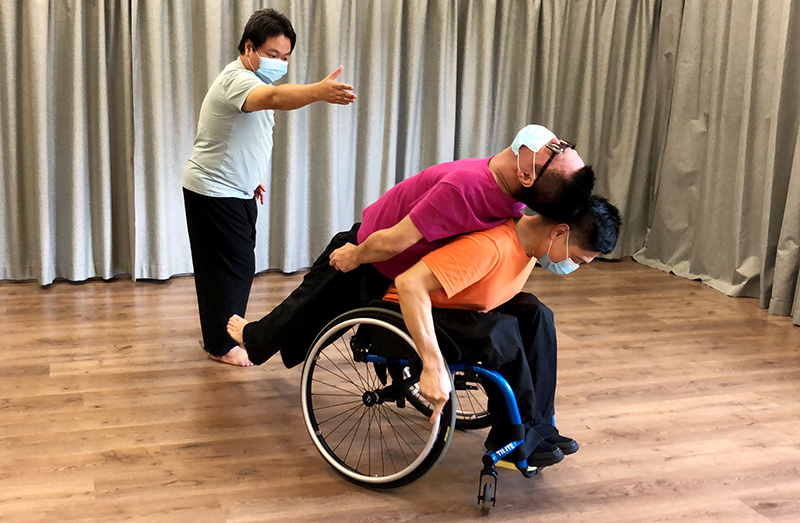
Footage for World Dance Day 2020 in Hong Kong
Image description: One dancer leans forward in a wheelchair, another dancer leans on his back, a third dancer stands behind them and reaches his arm out to them.
Any other thoughts?
Usually in Hong Kong, we say “people with disabilities,” but we would like to encourage more people to use “people with different abilities.” We really believe every person has unique and different abilities. That’s why we created the Artscompana platform for them to unleash their potential.
For example, at Theatre in the Dark, there’s a young guy with mental disabilities and autism. People with autism often have some fixation on things being a certain way. The guy was working backstage during a performance in complete darkness where the props had to be precisely placed in position. Because of his fixation, the props were properly placed. His characteristics, rather than limitations, helped us in our performance. He just needed a suitable platform. We hope to be one of the parties to provide this kind of diversity.
Sometimes people without disabilities underestimate what people with disabilities can do. They want to over-protect them. My husband and I would like to break this stereotype.
~~
To learn more about Scarlette’s work, visit scarlettecheng.wixsite.com/dance (link in Chinese).
To learn more about Artscompana, visit www.artscompana.org (link in Chinese).
To learn more about Theatre in the Dark, visit www.tidhk.com (link in Chinese).
To learn more about DanceAbility Hong Kong, visit danceability.com.hk.
